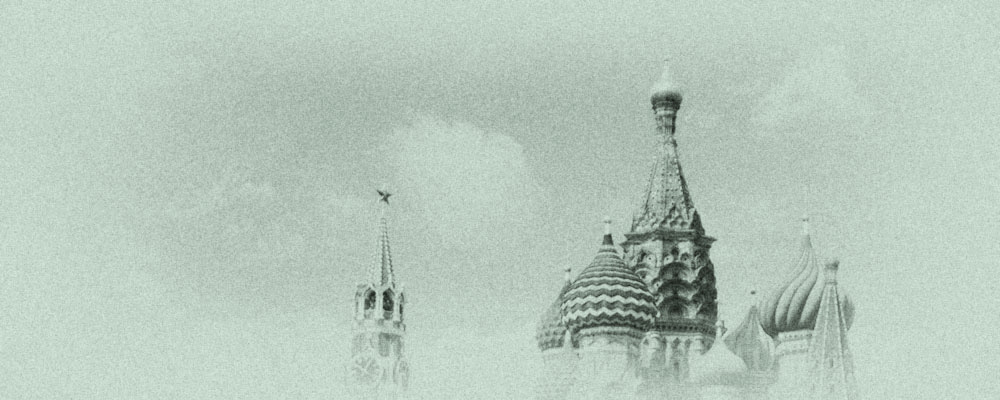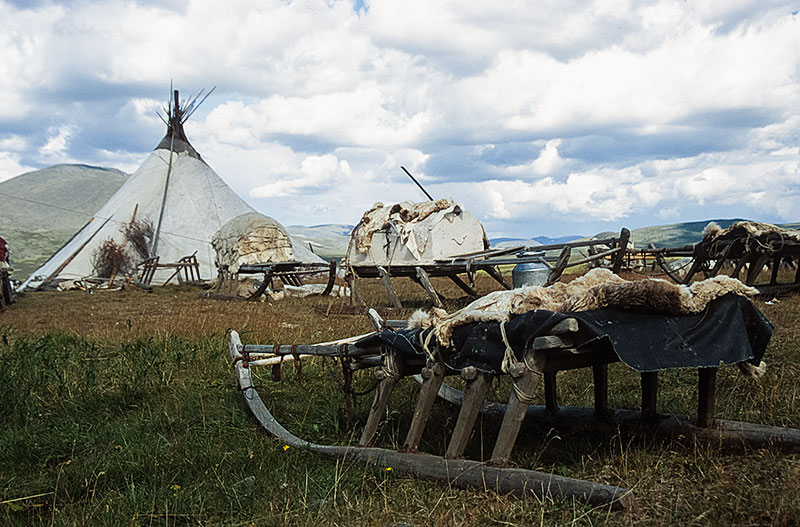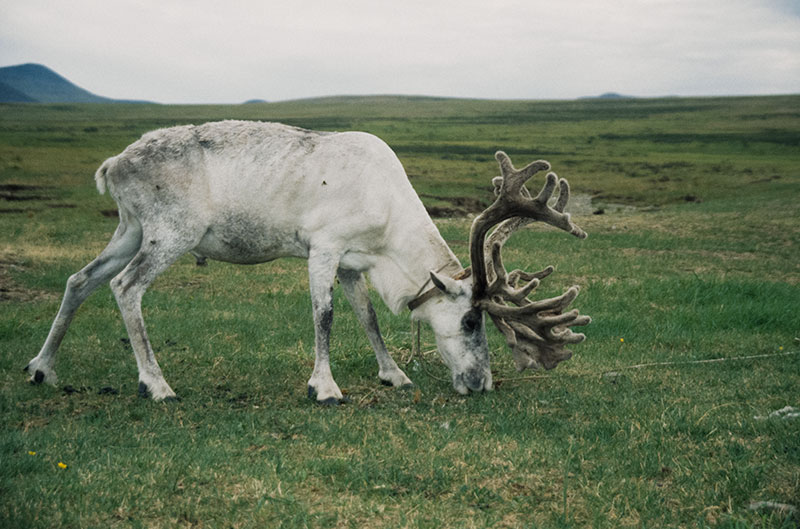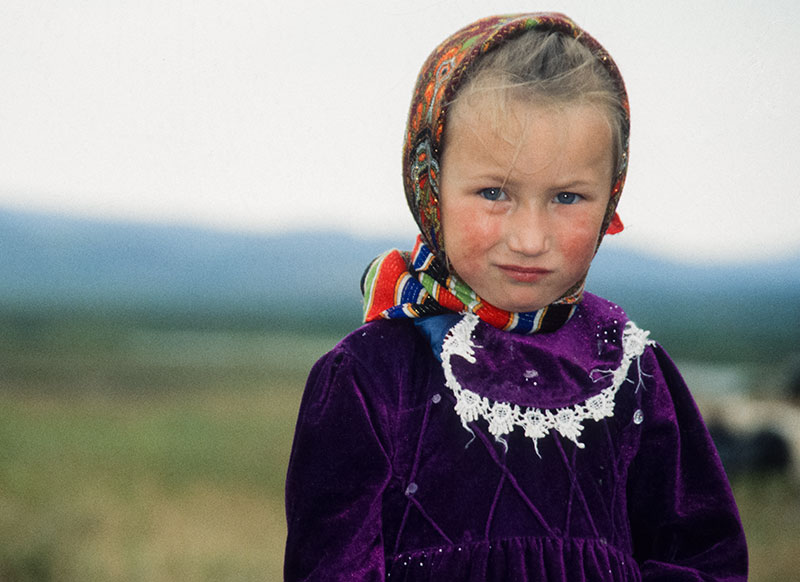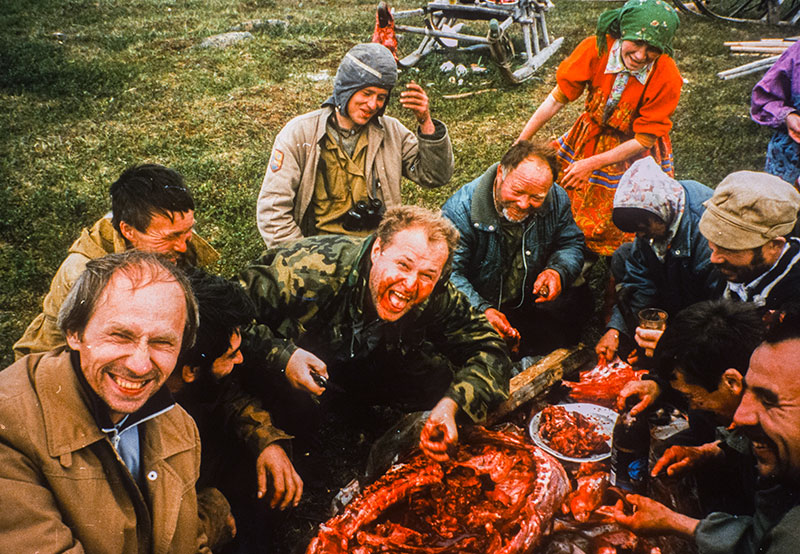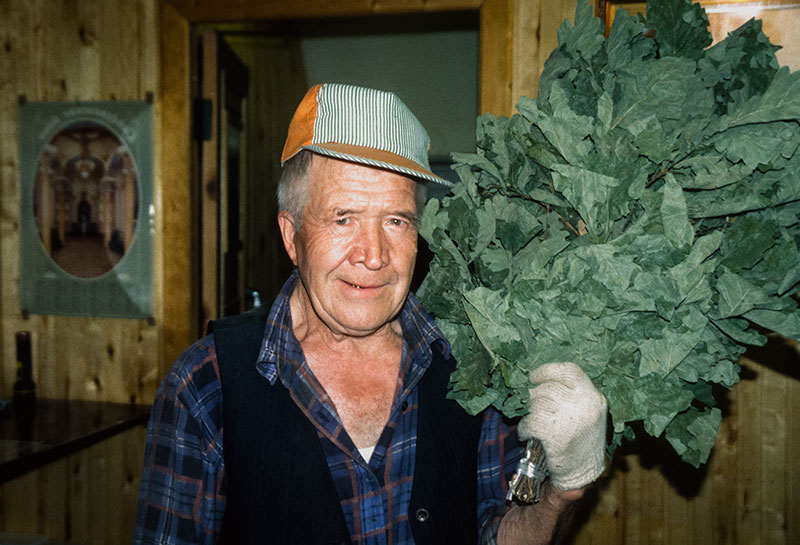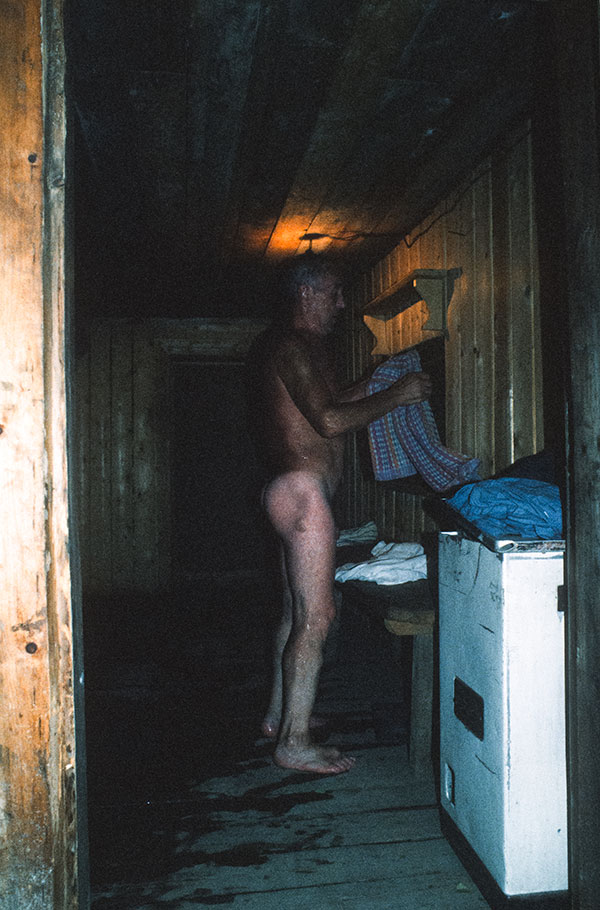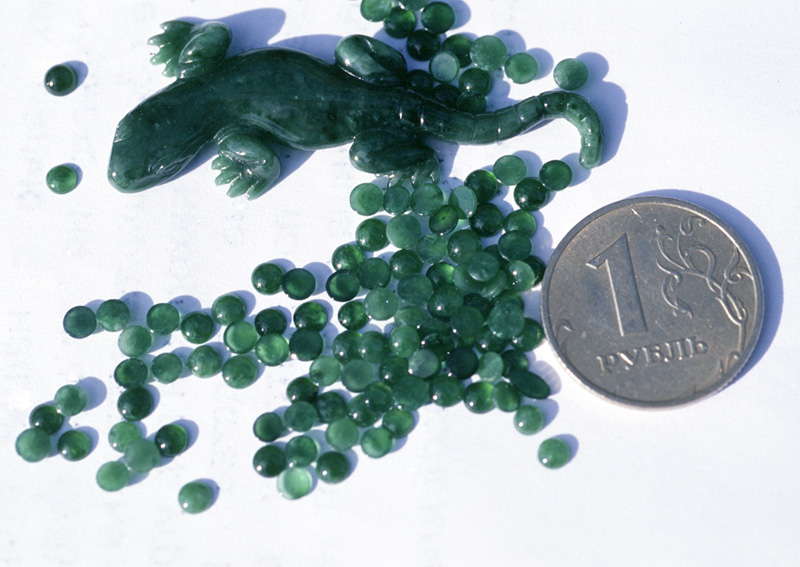Jadeite jade is a stone intimately associated with Burma (Myanmar). But there are deposits in other countries. This article details Russia's jadeite deposits in the Polar Urals and Khakassia.
Russian Jade Deposits • From Russia with Jade
It is an old axiom that precious stones are rarely found in good places and nowhere is that more true than with jade. Burma, the world's premier source features mines located in a miserable piece of SE Asian shrubbery that would have even George of the Jungle screaming for Agent Orange. Thus when I learned that top-grade jadeite had been discovered in Russia, I quickly made plans to expect the worst. Topped up my life insurance, said my last goodbyes to relatives and friends, gave away my collection of Velvet Underground records and canceled my lifetime subscription to The Watchtower. That last one really hurt.
My companion and guide for my Russian sojourn was Nickolai Kouznetsov, a Kazakhstan-born Russian whose love of gems and minerals is matched only by his prodigious consumption of vodka.
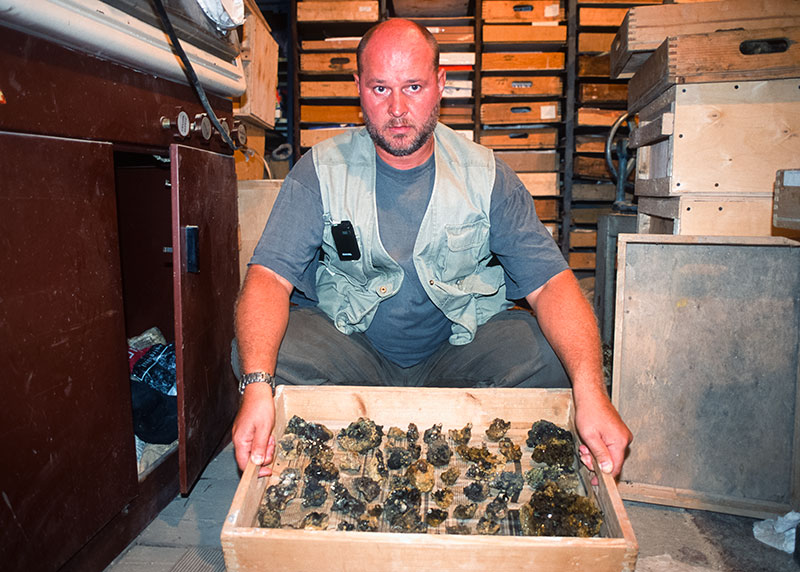 Nickolai Kouznetsov of Stoneflower Co., holding a large box of rutile specimens from the Caucasus Mountains in his Moscow office. Photo: © Richard W. Hughes
Nickolai Kouznetsov of Stoneflower Co., holding a large box of rutile specimens from the Caucasus Mountains in his Moscow office. Photo: © Richard W. Hughes
Our journey to the Russian jade mines began in the capital of Moscow, a citywide case of schizophrenia, a Joseph Stalin commie habit sandwiched around a burgeoning case of youthful freedom. Moscow is a beguiling collection of contradictions.
The first stop in Moscow was Stoneflower, Nickolai's mineral and gem company, housed in Andreievsky Monastery, which dates to the 16th century. It was here that I viewed my first Russian jade, and also here that I drank my first Russian vodka. Both events would be repeated many times during my three weeks in the country.
Two days later, we set off for Salekhard, from Sheremetevo #2, one of Moscow's six airports. At some point in the Soviet period, it was decided that an airport was needed for each point on the compass, a sweet thought, but one that makes for pure hell when flying into Moscow with the idea of changing planes and departing in a different direction.
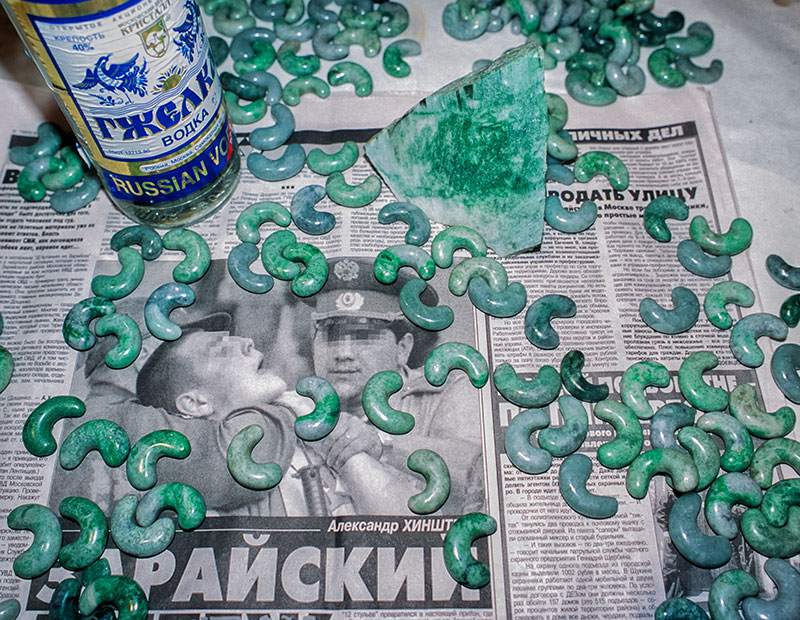 Local produce – Russian vodka and ornamental jadeite from Kazakhstan. Photo: © Richard W. Hughes
Local produce – Russian vodka and ornamental jadeite from Kazakhstan. Photo: © Richard W. Hughes
Polar!
At Salekhard, we are met by Sergei Mikheev, one of the discoverers of the Polar Urals jade deposits. From Salekhard, a short ferry ride across the River Ob brings us to Labutnangyi, but not without incident. Our captain ripped a rail off another ferry leaving the dock. No doubt he had been hitting the vodka. A one-hour drive brings us to Kharp, at the base of the Ural mountains, where we will spend the night. One thing about the roads up here is that you don't need to worry about driving at night, because during the summer, there isn't any – night, that is. August in the Arctic Circle is the time of "white nights." When the sun does dip below the horizon, it is for just a brief period, before coming back two or three hours later.
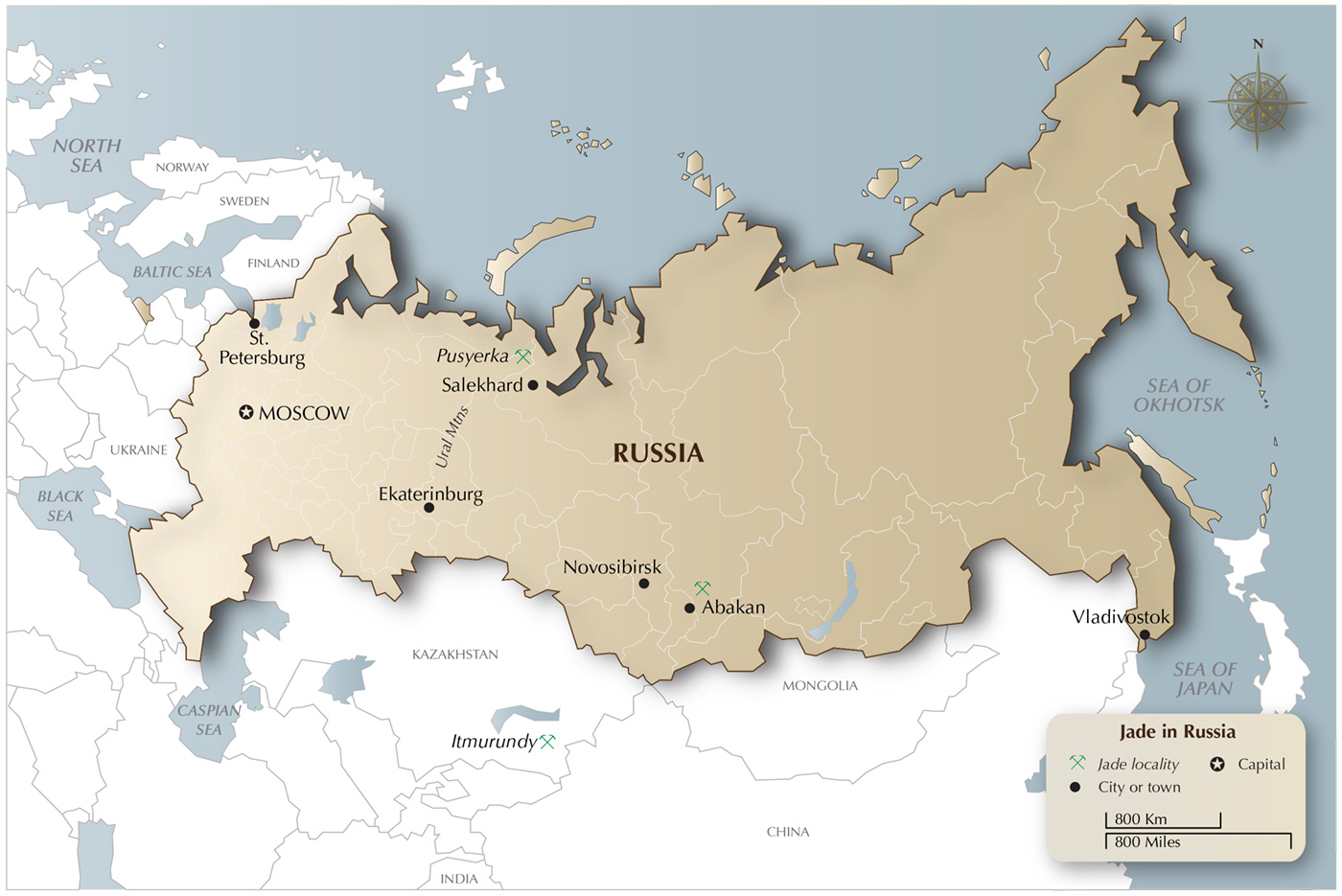 Map showing the important jadeite localities in Russia and Kazakhstan. Click on the map for a larger version.
Map showing the important jadeite localities in Russia and Kazakhstan. Click on the map for a larger version.
Illustration: R.W. Hughes
Kharp is quite frankly, depressing, a monochrome mixture of rust and concrete, a gray gulag of a town, whose major industries are cement and prisons. Even the sky displays a leaden, industrial quality. Not even the slightest attempt is made at gaity or beautification, as if even the thought is too much work under these harsh conditions.
This is the land of permafrost. While no snow is visible, only the first few feet of earth are thawed; below that all is frozen. To beat the cold, all houses are built above the ground and insulated pipes also run above ground. At times, one sees telephone poles sticking out at crazy angles, evidence of the yearly cycle of freezing and thawing that makes it impossible to anchor anything into the soil.
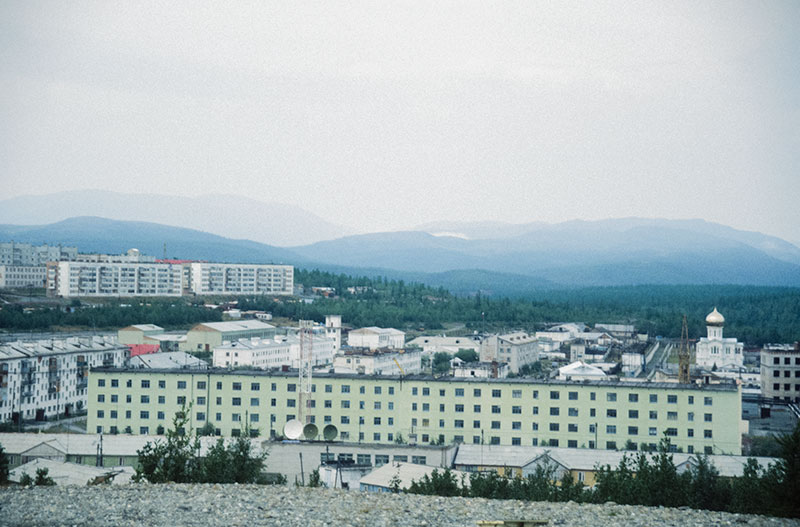 The Polar Ural town of Kharp, jump-off point for the Polar jadeite deposits. Photo: © Richard W. Hughes
The Polar Ural town of Kharp, jump-off point for the Polar jadeite deposits. Photo: © Richard W. Hughes
We arrive at the Kharp "Sheraton," our night stop, a dimly lit above-ground cellar. Take a cheap Indian brothel, reduce the size of the windows and paint everything gray and you'll get the picture. But our room does have an attached kitchen. This is a common feature in Russian hotels, for the concept of restaurants and dining out is a new one in the former Soviet Union. Even today, years after the fall of communism, less than one percent of the population of Russia takes more than one restaurant meal per year. Yes, per year.
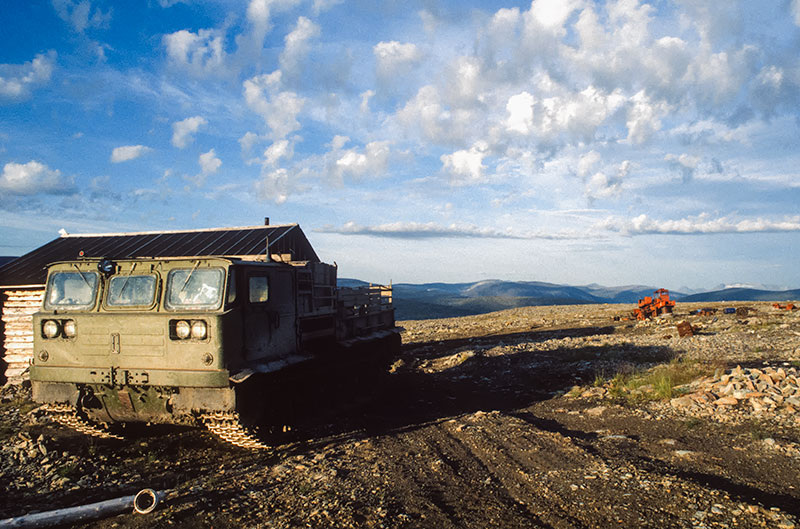 The armored personnel carrier that transported the author to the Polar Urals jade mines. Photo: © Richard W. Hughes
The armored personnel carrier that transported the author to the Polar Urals jade mines. Photo: © Richard W. Hughes
Tanked up
Transport to the mines, some 160 km from Kharp, was via a Russian armored personnel carrier (APC). After climbing aboard in a vacant lot in the middle of Kharp, our driver turned over the engine and the roar called out: "Are you ready to RUMMBBBBLLE?" Verily. Banking quickly out of the lot, one city block later we encountered a river. Whoosh, our vehicle splits the water like Moses parting the Red Sea. Then it was up onto the opposite bank and thus began one helluva ride. I felt simultaneously like a can of paint in a shaker and Rommel in a blitzkrieg on the Russian steppes. Tree in the way. No problem – drive right over the sucker. Rivers? We crossed several that were close to two meters deep. Over hill, dale, mound, rock, and every other manner of obstruction. Mud, rocks, trees – nothing could stop us. After my 1996–97 visits to Burma's jade mines, I thought I knew what a bad road looked like, but these polar paths were their equal to the nth degree. The difference was our vehicle, which made mincemeat out of every bit of terrain thrown at it.
After an hour of white knuckling across tundra, river and forest, I turned to Nicky and asked about just how far away these mines were. With a sly smile he replied: "Only nine more hours." "Nice," I thought as I chewed on my tongue. If I ever do get down off this tundra tank, my butt cleavage will make Dolly Parton look flat-chested.
|
Here come the Komis Imagine this. After close to six hours of bouncing across the Polar tundra, we cross a rise and encounter a scene straight out of the old American plains. Teepees dot the landscape, surrounded by sleds, with reindeer grazing peacefully nearby. As we rumble closer, white-skinned people dressed in red tribal outfits emerge from the tents and it hits me – I've just discovered the summer home of Santa Claus.
What we had found was an encampment of Izhma Komi (yes, pronounced like 'commie'). While there are over 500,000 Komi in Russia, the Izhma Komi number but a few thousand. These are the tundra Komi and unlike the other groups have reindeer herding as a main source of income. In addition to the Komi, another tribal group, the Khant, are also found in the Polar Urals. But in contrast to the Komi, who have white skin and blue eyes, the Khant are more Mongolian in appearance.
|
Timeless
Scenery along the way was just beyond spectacular. Treeline this far north is probably less than 500 meters above sea level, with the highest peaks in the Polar Urals topping just over 1000 meters. But it is hard to be a tourist amidst the roar and bounce of this Russian Taiga tank. Occasionally we would pass a small settlement, but otherwise there was little sign of human activity. Only wave after wave of forest, green hills and tundra. After three hours of bone-jarring action, we crossed a small rise and came to a river. Standing along the bank was a wizened old man with what looked like all his worldly possessions on the back of a small wheeled luggage cart. Obviously waiting for the next train to Nowheresibirsk. He flags us over and blurts out something in Russian. Translation: "What day is it?"
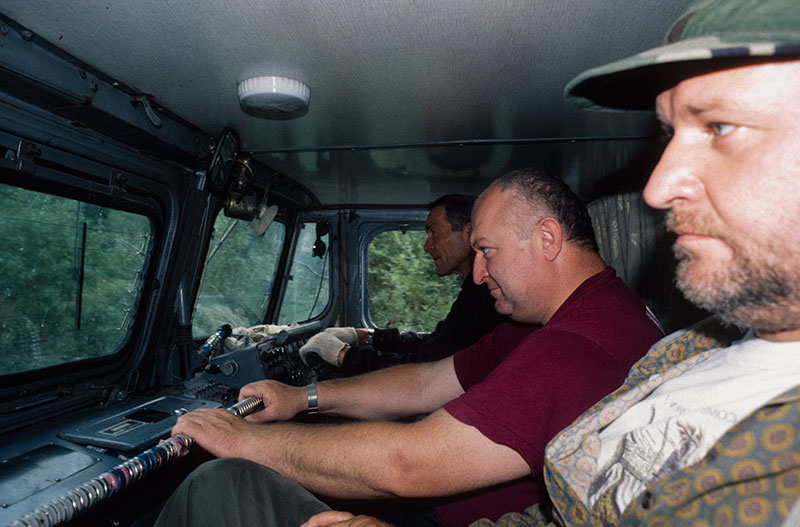 White-knuckling it across the Polar taiga. Photo: © Richard W. Hughes
White-knuckling it across the Polar taiga. Photo: © Richard W. Hughes
Mine at last
Nine hours into our journey and I've made an important decision. Upon my return to Moscow, I will register a complaint with the Russian highway department, and then go right into the pearl business, because I cannot take these jade roads anymore. The KGB had no need for torture. All that was necessary was to bring a prisoner up here. Ten hours of this road and anyone would give up state secrets. How did I come to be here? How did John Hinkley come to shoot Ronald Reagan. I don't know. I have no fixation with Jodie Foster, I have no answers, but am obviously just as nuts as Hinkley.
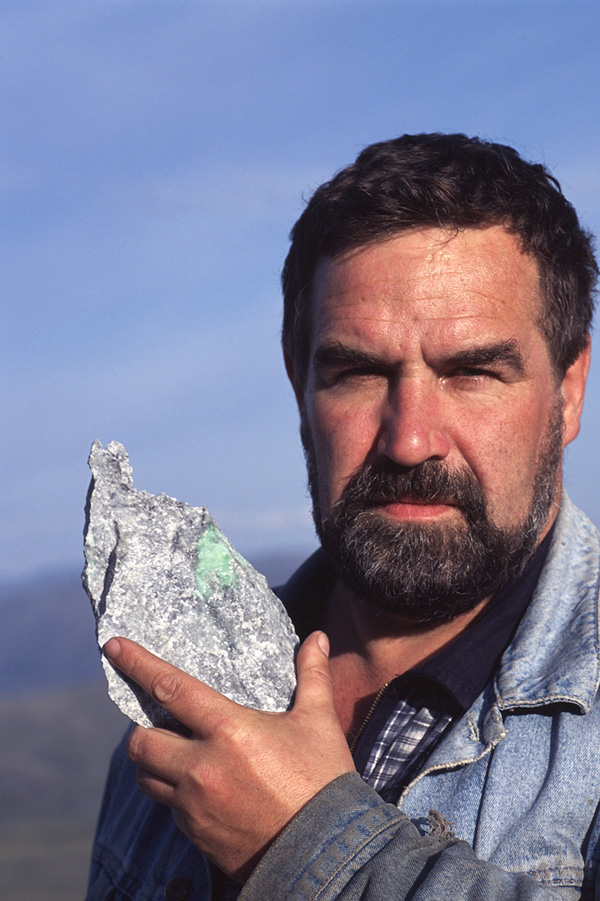 Geologist Sergei Mikheev, with a piece of Polar jadeite. After ten years of looking Sergei discovered the first piece of jadeite in the Polar Urals. Photo: © Richard W. Hughes
Geologist Sergei Mikheev, with a piece of Polar jadeite. After ten years of looking Sergei discovered the first piece of jadeite in the Polar Urals. Photo: © Richard W. Hughes
Eventually we arrived at the mine site, Pusyerka, also known as Lot 88. A few ramshackle mine buildings showed evidence of past mining activity. How anyone ever discovered a gem up here is beyond belief. The country just oozes emptiness. It would be beautiful, were it not for the thought that, in a day or two, we will have to make this same journey back.
Exploration for jade in the Polar Urals was begun by a Russian geologist named Yevgeny Kouznetsov (not related to Nickolai). In 1979, geologists mapping the area discovered rocks favorable for the formation of jadeite. Sergei Mikheev joined the yearly expeditions in 1985. Patiently they explored, during the three months per year when the snow and ice yielded to the sun. In the summer of 1989, Sergei reached down and picked up a stone that would change his life. Incredibly enough, after ten years of looking, he had found his first piece of jadeite. And it was no ordinary jadeite, but imperial jade, of a quality that compared favorably with the fine material from Burma.
Sergei took that first piece to Hong Kong, where he showed it to one local jade trader. Only a trace of imperial green was visible at the surface. When Sergei voiced his belief that the green vein would continue throughout, he met only skepticism. So Sergei made the Chinese an offer. The stone would be sawn open. If the green continued throughout, Sergei would receive his asking price. And if the green disappeared, the Chinese would pay his much lower offer. As the saw blade parted the boulder, the tension was palpable. When it reached the end, each half of the boulder tumbled away, revealing a fine emerald-green color within. Sergei's belief in his stone was vindicated. And the Chinaman became a believer. He later invested heavily in the mining, but alas, could not wring enough profit out of it to continue.
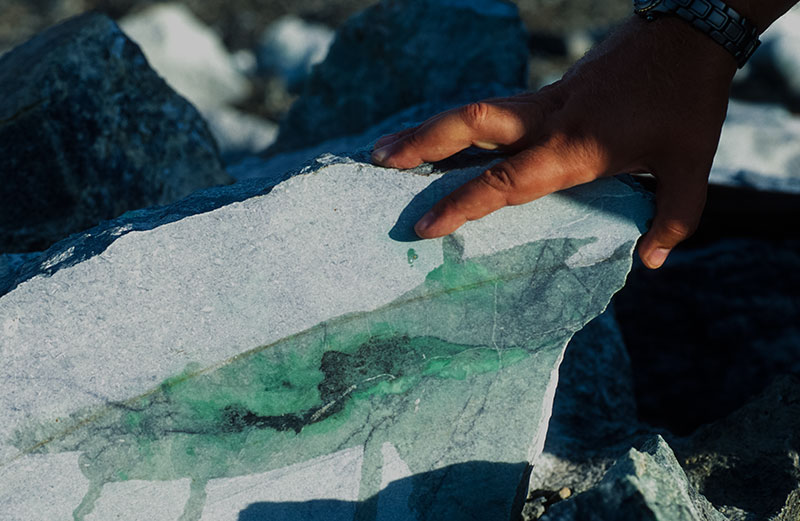 Green veins are clearly visible in this large block of jadeite at Lot 88 in the Polar Urals jade mines.
Green veins are clearly visible in this large block of jadeite at Lot 88 in the Polar Urals jade mines.
Photo: © Richard W. Hughes
88 different outcrops of jadeite have been identified in the Polar Urals. At Lot 88, we could see remnants of the mining activity. Everywhere along the ground lay pieces of white jadeite, riddled here and there with veins of intense green. The jadeite in this area occurs in dikes within a serpentine matrix, with actinolite and phlogopite and from all appearances much material remains. But there is that old bugaboo, the weather. Today, the mine lies fallow, awaiting another visionary investor, someone who can see the promise in the green stone. And Sergei continues in his belief that if the right investor can be found, the icy green stone from the Polar Urals will take its place alongside Burma in the pantheon of imperial jade.
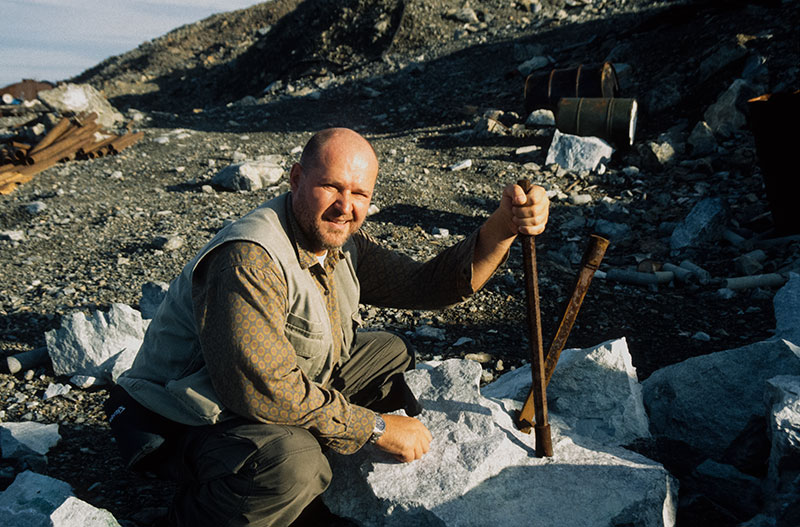 Nickolai Kouznetsov demonstrating how large jadeite blocks are split for transportation at the Polar Urals jade mines.
Nickolai Kouznetsov demonstrating how large jadeite blocks are split for transportation at the Polar Urals jade mines.
Photo: © Richard W. Hughes
|
Good Clean Fun
Russia offers a unique blend of customs, and there is certainly nothing more unusual than that of the banya, or sauna. I normally consider myself a level-headed, sober individual, and dislike those who rejoice in the idea of "getting crazy," "walking on the wild side" and "letting it all hang out." Thus when my friend Nickolai suggested that we visit a Russian banya, where we would get naked in a room just slightly below the melting point of Satan's trident, beat each other across the back and neck and shoulders with branches, and then plunge into a pool of ice-cold water, my reply was simple: "Yeah, baby, let's do it!"
According to the Russians, you cannot consider yourself truly clean until you have gone through the ritual purification of the banya. The first step is to obtain bundles of birch branches (the bundle I selected was particularly nice). Then it's off to the banya. These are sex-segregated locker room-cum-bath houses where one strips for a quick shower before moving on to the warm-up room. Finally the main event, a wooden hot box where naked Russian sadists continually splash water onto hot rocks, sending up pillars of scalding steam which increase the temperature to solar levels. Being a novice in the banya scene, my friend Nickolai suggested I go first. He asked me to lay face down upon a wood bench and proceeded to beat me senseless with the birch branches. This lasted about 10 seconds – the time it took for me to arise screaming from the third degree burns on my… hmm… let's just call him Peter. After applying the same to Nickolai, we fled the hot room, plunging into a pool of ice water. This is said to increase blood flow. I suppose it works – at least for those whose heart continues to beat after the shock. According to Nickolai, some Russians actually build their banyas near a lake so in winter they can go directly from Hell to a hole in the ice. A brief shower and several skin grafts later, Nickolai said it was time to do it again – and so we did, repeating the process over and over. Finally, the banya ritual was finished off with massages by two hefty Russian bears. During the massage, I began to consider making a permanent move to Moscow. My skin literally glowed, and as we glided out of the banya house I felt cleaner than I had ever been in my life. Banya? Yeah, baby, let's do it! |
Fortune strikes
Shortly after returning from the Polar Urals, Nickolai and I found ourselves shooting a game of pool in a Moscow taproom when fortune smiled upon us. We were approached by a manic man with a cat-that-ate-the-canary grin named Mikhail "Misha" Khronlenko. An old friend of Nickolai's, Misha also happened to be Russia's biggest jade miner and exporter. After much banter and vodka during dinner the next evening, Misha told us he would be leaving soon for his jade mines in Khakassia and invited us along. As Misha explained it, "every dog gets his day." and if we would come with him to Khakassia, he promised "a fantastic day."
Not so fast. With the experience of the ten-hour Polar ass-cracker fresh in my mind, I needed to know more. Just where were these mines? Misha smiled and replied that they were just two hours outside the capital on a good road. Oh, reel-lay? How could we refuse? A day later we found ourselves on a plane bound for Abakan, capital of Khakassia.
Let me say this from the outset. Air Abakan is not the Concorde. No sleep at all. I spent most of the flight obsessing that if the seat in front of me moved back even one more centimeter, the air hostess would have to remove me with a decal scraper. Over six hours after deplaning, the Air Abakan bird logo from the seatback in front of me was still plainly visible on my crushed nose. Which wasn't necessarily a bad thing, considering that my blocked nasal passages hindered the entry of the airline's unique aroma.
The Republic of Khakassia lies in Siberia, just north of Altay and Tuva, near the border with Mongolia. Indeed, a walk through the market in Abakan, shows a strong Mongolian influence, with perhaps 10–20% of the population being of Mongolian origin. But ethnic mixtures abound. I'll never forget seeing one family walking down the street. Both mother and father displayed strong Mongolian features, with round faces, black hair and narrow eyes that would have been entirely in place in Beijing. Their child had identical features, except for one – blond hair – testament to the fact that Khakassia has been a crossroads of conquerors for centuries.
The capital, Abakan, means "bear's blood," a reference to a local legend of its founding. It was founded in 1693. Today the population is 160,000. According to legend, in the early days a large bear took a liking to the local ladies, particularly those who were young and beautiful. This bear ate so many young virgins that the Hun declared that any man who could slay the bear could marry his daughter. In the ensuing fight, one man stabbed the bear over and over. The bear's blood flowed out, clearing the valley and forming the river. Thus the name, Abakan, which means "bear's blood." If this isn't enough, Ghengis Khan is said to have buried his treasure somewhere in Khakassia. It was never found.
The jade mines in Khakassia are situated near the banks of the Yenisey River, near Sayano-Shushenskaya, one of Russia's largest hydroelectric dams. A two-hour drive from Abakan brought us to the lake created by the dam. From here, the mine lay some one-and-a-half hours across the lake by boat. Forest is everywhere. After Moscow, the air up here almost chokes you with its clarity. Thirty-six hours without sleep and I am exhausted. But eventually I move beyond exhaustion, where an epiphany is reached and I realize just why I travel. Here I am, out on a lake in the middle of Siberia, and all is well, all is peace, all is right in the world. Russia is such a land of contrasts – amazing!
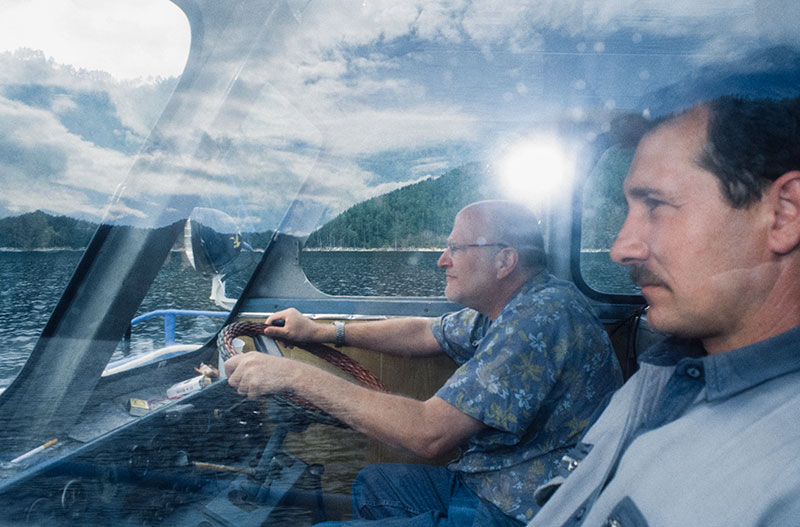 The author getting down to serious business – piloting a boat on the Yenisey River, near the Khakassia jade mines. Due to the large number of logs floating in the reservoir, one must remain ever vigilant. The year before my visit, Misha was on a boat in this reservoir and, not paying attention, hit a swimming bear. Needless to say the bear was not happy.
The author getting down to serious business – piloting a boat on the Yenisey River, near the Khakassia jade mines. Due to the large number of logs floating in the reservoir, one must remain ever vigilant. The year before my visit, Misha was on a boat in this reservoir and, not paying attention, hit a swimming bear. Needless to say the bear was not happy.
Photo: © Richard W. Hughes
Truckin'
Arriving at the mining camp, we were greeted by Misha's brother and father and were pleasantly surprised at the comfortable Siberian accommodations, complete with banya. The mine employs some twenty people and the climate allows mining over seven months per year. To get to the mines, we hopped in a truck and took off on one of those incredibly steep, muddy tracks that seem to be found only on the way to a jade mine. We could have walked, but I guess when you have a chance to get stuck in the mud, riding is more fun.
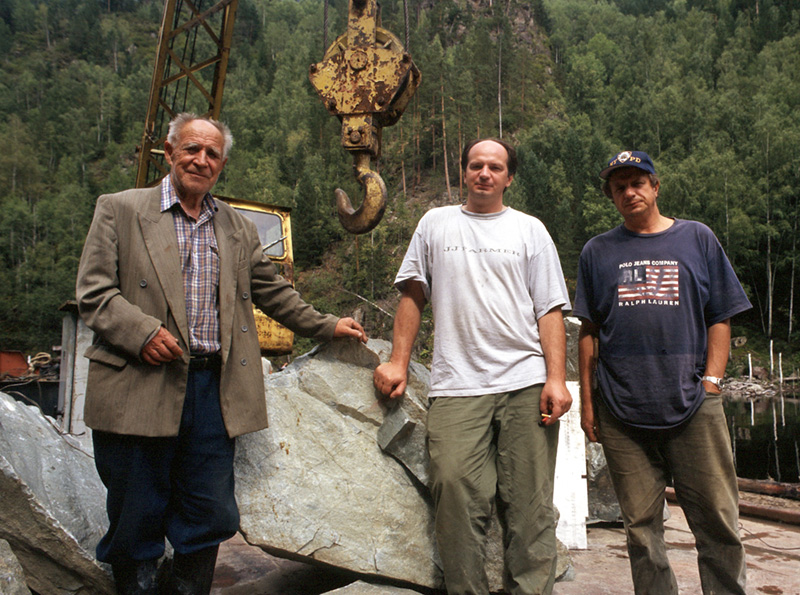 Mikhail "Misha" Khrolenko (center) and his father Yakov Borisovich(left) and brother Sergei (right), owners of the Khakassia jade mines. They are standing in front of a huge chunk of Khakassia jadeite. Photo: © Richard W. Hughes
Mikhail "Misha" Khrolenko (center) and his father Yakov Borisovich(left) and brother Sergei (right), owners of the Khakassia jade mines. They are standing in front of a huge chunk of Khakassia jadeite. Photo: © Richard W. Hughes
There is something about a jade mine that seems to bring out the worst in roads. An intense five-minute drive later, we arrived at the mine. Amidst a hillside open cut stood what is probably the single biggest jadeite boulder I have ever laid eyes on. Workers crawled across its surface like ants, sticking their jackhammer stingers in to pry away small bits, which were loaded onto waiting trucks. As I marveled at the scene, Misha was beaming. "What do you think?" he asked. "It's incredible," I gushed. "Yes," Misha answered, laughing that manic laugh: "Every dog gets his day."
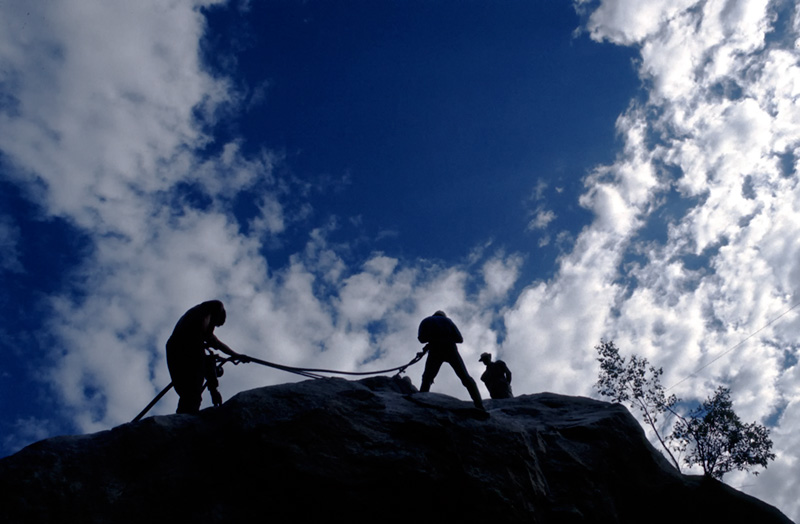 Working a house-sized boulder of jadeite at the Khakassia jadeite mines, near the Yenisey River
Working a house-sized boulder of jadeite at the Khakassia jadeite mines, near the Yenisey River
Photo: © Richard W. Hughes
Kidnapped
The next day it was back down to Abakan, where we proceeded to consume copious quantities of vodka as Misha regaled us with stories of jade and life in Siberia. Early the next morning, we rushed to the airport, only to find that the Air Abakan flight was full.
After missing our plane, I expected a couple restful days in Abakan, but Misha had other plans. The previous night's vodka fest had left each of us with little sleep and far fewer brain cells, but that did nothing to stop our dynamo guide. We paid a visit to a gold miner in a nearby town, and then it was off to a dacha in the countryside. Two-and-a-half hours drive later, I was beginning to understand how Patty Hearst must have felt. Eventually, we arrived at a lake. I was in miserable condition, with too little sleep and too many miles on my body, thinking to myself, "Why am I here?" I really am too old for this jade mines stuff.
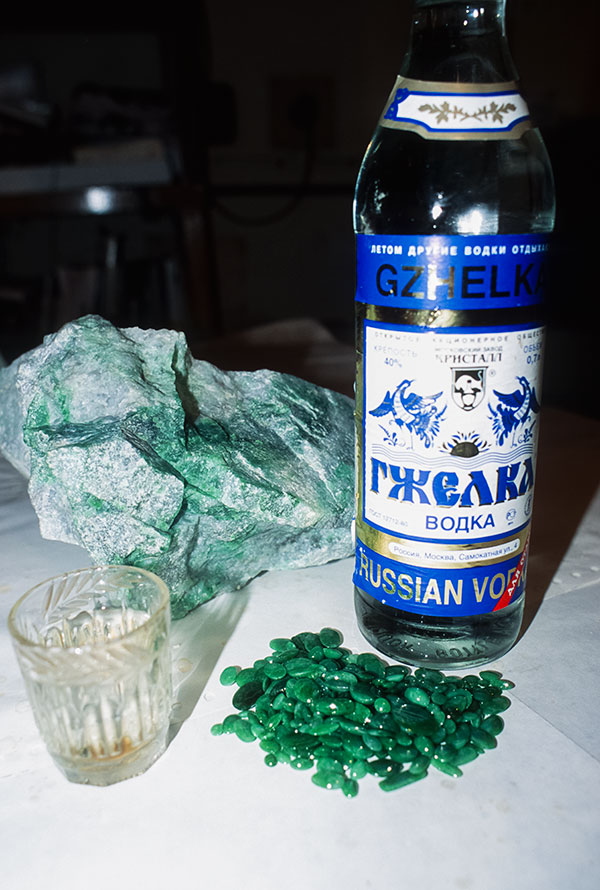
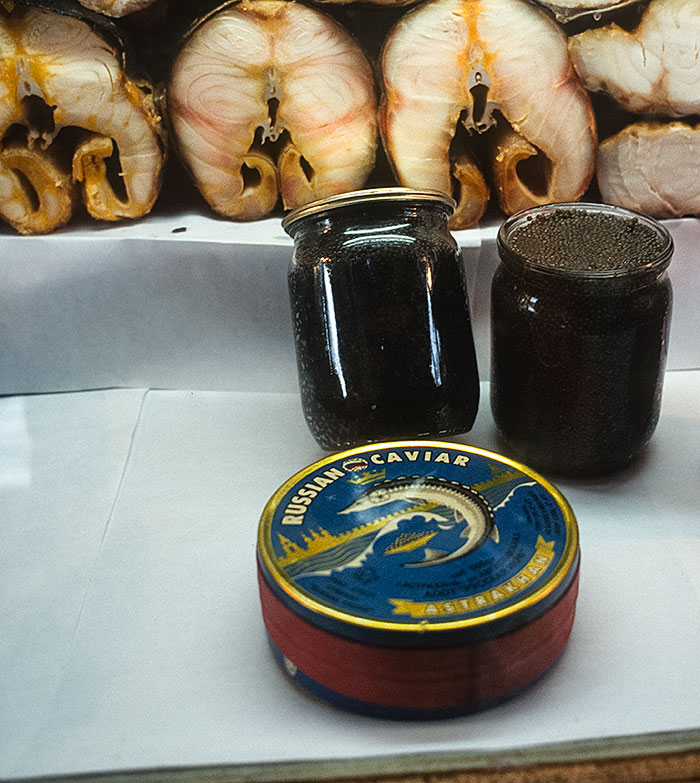 Product of Russia. At the time of writing (2000), a 500-gram jar of beluga "black" caviar such as that shown cost about $150. Today (2014) it is completely banned to protect the sturgeon, from which it comes.
Product of Russia. At the time of writing (2000), a 500-gram jar of beluga "black" caviar such as that shown cost about $150. Today (2014) it is completely banned to protect the sturgeon, from which it comes.
Photo: © Richard W. Hughes
The next day, recovering, I climbed a mountain above the lake. As dark clouds swirled above my head and a hawk traced lazy circles off the cliff at my feet, the answer appeared. Looking out upon the hills, the sheer vastness of the land beat open the doors to my consciousness. These hills and steppes stretched on unbroken for thousands of miles in every direction, the largest wilderness left on the planet. It had a calming effect. Even as the rains forced me down off the mountaintop, the sun was shining in my mind and heart.
In Dreams
Down below, we had a final meal before departing for Abakan and I had an opportunity to speak with Misha about his dream. He was born in Khakassia and has a deep love of his homeland and its peoples. His family was once rich and powerful, but when a brother married an American student in Moscow and immigrated to the USA, they were ostracized from Soviet society. Misha went through a number of different businesses, everything from truck driver to vodka maker before being told one day of the jade that had been found in his homeland. He was immediately smitten, deciding then and there to make it his life's work.
Misha's decision seemed ever more right when his wife read to him an encyclopedia entry on jade, which stated that, next to colored diamonds, jade was the most precious of all stones. And so he set out to learn all he could about the subject, visiting Hong Kong, studying up on this gem that he hoped would become his life's work. "I have looked at all the jade deposits in Russia and Kazakhstan," Misha told me. "The Polar deposits have fine material, but the conditions are too severe, while the quality of material from Kazakhstan is not good enough. But here in Khakassia, we have the perfect combination – an accessible deposit with good material. I know it is not as good as the best from Burma, but it is quite nice and I am positive that with hard work, we can be successful."
As we packed our bags to leave, one building next to the lake caught my eye. It sported a window, but where the glass should be, the frame was filled with bricks. Above, clouds clashed in the sky. This seemed to symbolize all that is Russia today. Looking outward, but after 80 years of communism, somehow afraid of what she might find. Mother Russia moving, like the clouds, simultaneously in two opposite directions.
We hit the road as the sun's final glow began to fade. A more beautiful sunset I have never seen. Stopping the car, Misha and I look each other in the eye, smiling, then take in the vast Siberian expanse that lies before us. He tells me: "Khakassia – this is a big, big country. We are small." Just then, a rainbow shoots down through the clouds. As we embrace I tell him, "Now I understand why you brought me here." I think I've discovered that lost treasure of Ghengis Khan. "Yes," he nods knowingly. "Every dog gets his day. Every dog gets his fantastic day."
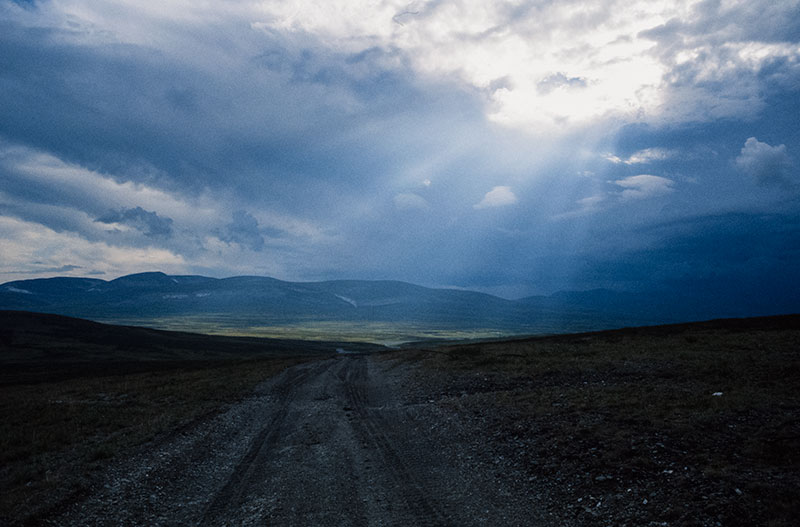 Russian treasure. Photo: © Richard W. Hughes
Russian treasure. Photo: © Richard W. Hughes

|
What is Jade? Over 2500 years ago, Gautama Buddha recognized that much of life involves pain and suffering. So few of us here on Earth have been provided with a glimpse of heaven. Instead, we mostly dwell in hell. But for the Chinese, there is a terrestrial bridge between heaven and hell – jade. While stones such as diamond are a relatively recent entry into Chinese culture, jade has a history stretching back thousands of years. In ancient China, jade was already used for making tools, weapons and ornaments. Jade's antiquity contributes an aura of eternity to this gem. Confucius, who wrote about its brilliance and beauty, praised jade as a symbol of righteousness and knowledge.
Part of the Chinese' love of jade is its beauty and toughness. But they also ascribe mystical powers to the stone. A circular piece of jade, such as a bangle, is said to possess a protective function. If the wearer is caught in an accident, the jade will break, leaving its owner unharmed. Even more popular is the belief that it is possible to predict the stages of one's life, depending on whether a jade becomes more brilliant and transparent – meaning enjoying good times and good fortune – or whether it becomes dull – meaning there is bad luck ahead. Just how does one classify a piece of heaven? To the Chinese, jade was defined by its "virtues," namely a compact, fine texture, tremendous toughness and high hardness, smooth and glossy luster, along with high translucency and the ability to take a high polish. But the Occidental psyche, with its propensity to pigeonhole, does not sit well with such apparent indifference to scientific definition. Thus it was left for the intruders from the West to finally cross all the t's and dot the i's of this most arcane of gem substances. In 1863, French mineralogist Alexis Damour analyzed bright green jades from Burma. Finding them different from ordinary Chinese jade (amphibole jade, or nephrite), he named the "new" jade, jadeite. Today, gemologists apply the term jade only to amphibole jade (essentially a nephrite rock) and pyroxene jade (essentially a jadeite rock). Nephrite is a tough fibrous subspecies of the actinolite – tremolite series, whereas jadeite is a more granular, compact species of the sodium pyroxene mineral group. Depending upon impurities, the color of jadeite jade encompasses variations of white, through red- and orange-brown, light purple to violet ('lavender'), bluish gray and black, to an extensive range of greens. The "Imperial" (chrome) green, which is not found in nephrite, is the most highly valued. A love of jade was not limited to the Chinese. Wherever the stone was found, it was held in great esteem, from the nephrite of New Zealand's Maoris, to the jadeite of Mesoamerica. Indeed, as Cortez cut his swath through the Aztec empire, pillaging gold, silver and emeralds, Montezuma is said to have remarked to his followers: "Thank god they don't know about the jade." Gold, silver and precious stones might capture interest in the rest of the world, but in cultures familiar with jade, they were simply also-rans. In Chinese athletic competitions, ivory was given for third place and gold for second. Jade was reserved solely for the winners, including high officials in the imperial court. Within jade's verdant interior, the Chinese, Maoris and Aztecs saw all that is good with humanity – virtue, purity, justice, humanity, and more. As the Chinese saying goes: "Gold has a price – but jade is priceless." And today, many are beginning to wake up to this truth. As we enter the new millennium, jade is the world's most precious stone, fetching prices higher than anything except the rarest colored diamonds. Indeed, five of the ten most expensive jewelry lots sold worldwide by Christie's in 1999 were jade, including three of the top five. |
Acknowledgments
A journey such as this cannot be completed without the help of many people. First and foremost, William Larson, of Pala International, who gave me the time away from work to follow my dream. And my Russian buddy, Nickolai Kouznetsov, who allowed me to stumble in and out of trouble, but was always there with a steady hand when needed. Our host in the Polar Urals, Sergei Mikheev took the time to show us his dream. Dzhano Akhvlediani from Georgia was a fine traveling companion, always reminding us when our vodka glasses were empty. Sasha Agafonov and the rest of the gang at Stoneflower in Moscow. And finally, Misha Khrolenko and his brother, Sergei, and father, Yakov Borisovich, who so willingly opened up their Khakassian home and homeland to us.
For further information on jade, see also:
- Hughes, R.W., Galibert, O. et al. (1996–97) Tracing the green line: A journey to Myanmar's jade mines. Jewelers' Circular-Keystone, Vol. 167, No. 11, Nov, pp. 60–65; Vol. 168, No. 1, Jan, pp. 160–166.
- Hughes, R.W. and Ward, F. (1997) Heaven and hell: The quest for jade in Upper Burma. Asia Diamonds, Vol. 1, No. 2, Sept-Oct, pp. 42–53.
- Hughes R.W. (1999) Burma's jade mines: An annotated occidental history. Journal of the Geo-Literary Society, Vol. 14, No. 1, pp. 15–35.
- Hughes, R.W., Galibert, O. et al. (2000) Burmese jade: The inscrutable gem. Gems & Gemology, Vol. 36, No. 1, Spring, pp. 2–26.
- Hughes, R.W., Leelawatanasuk, T. et al. (2012) The Chinese box: A Guangzhou jade market puzzle. Journal of the Gemmological Association of Hong Kong, Vol. 33, pp. 50–53.
About the authors
Richard W. Hughes is one of the world’s foremost experts on ruby and sapphire. The author of many books and over 170 articles, his writings and photographs have appeared in a diverse range of publications, and he has received numerous industry awards. Co-winner of the 2004 Edward J. Gübelin Most Valuable Article Award from Gems & Gemology magazine, the following year he was awarded a Richard T. Liddicoat Journalism Award from the American Gem Society. In 2010, he received the Antonio C. Bonanno Award for Excellence in Gemology from the Accredited Gemologists Association. The Association Française de Gemmologie (AFG) in 2013 named Richard as one of the Fifty most important figures that have shaped the history of gems since antiquity. In 2016, Richard was awarded a visiting professorship at Shanghai's Tongji University. 2017 saw the publication of Richard and his wife and daughter's Ruby & Sapphire • A Gemologist's Guide, arguably the most complete book ever published on a single gem species and the culmination of four decades of work in gemology. In 2018, Richard was named Photographer of the Year by the Gem-A, recognizing his photo of a jade-trading market in China, while in 2020, he was elected to the board of directors of the Accredited Gemologists Association and was appointed to the editorial review board of Gems & Gemology and The Australian Gemmologist magazine. In 2022, Richard published Jade • A Gemologist's Guide, while 2024 brought Broken Bangle • The Blunder-Besmirched History of Jade Nomenclature. His jade trilogy was completed in 2025 with his translation of Heinrich Fischer's Nephrite and Jadeite.
Nickolai Kouznetsov is president of Stoneflower, a Moscow-based company specializing in Russian gems, minerals and fossils.
Notes
© 2000 Richard W. Hughes This article originally appeared in GemKey Magazine , Vol. 3, No. 1, pp. 58–66.
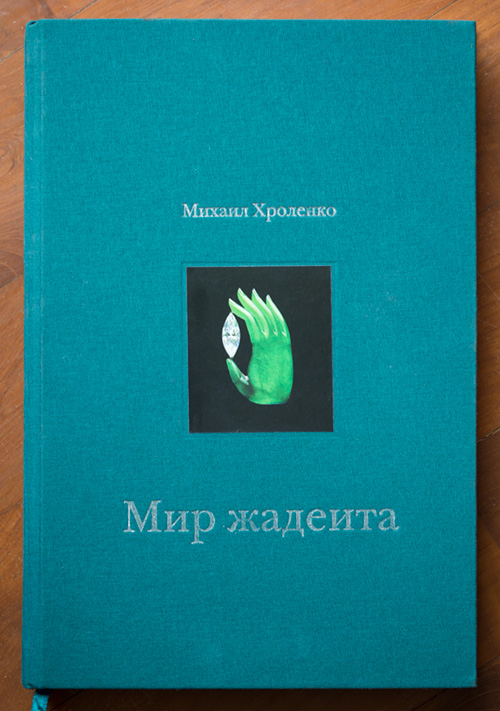 In 2008, Misha Khrolenko realized his dream, publishing a large volume, мир жадеита ('World Jadeite') that detailed the story of jade in Russia and elsewhere. Sadly he passed away just a couple years later.
In 2008, Misha Khrolenko realized his dream, publishing a large volume, мир жадеита ('World Jadeite') that detailed the story of jade in Russia and elsewhere. Sadly he passed away just a couple years later.

